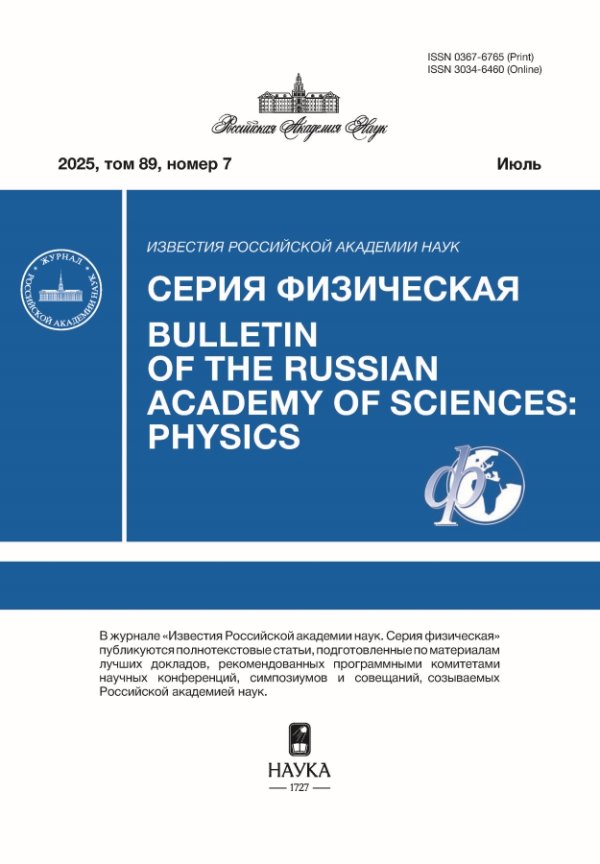3D-микроструктуры для ввода излучения в фотонные интегральные схемы
- Авторы: Колымагин Д.А.1, Проходцов А.И.1,2, Чубич Д.А.1, Матитал Р.П.1, Казанцева А.В.1, Емельянов Д.П.1, Ковалюк В.В.2,3, Витухновский А.Г.1,4, Гольцман Г.Н.3,5
-
Учреждения:
- Федеральное государственное автономное образовательное учреждение высшего образования «Московский физико-технический институт (национальный исследовательский университет)»
- Федеральное государственное автономное образовательное учреждение высшего образования «Национальный исследовательский технологический университет «МИСиС»
- Федеральное государственное автономное образовательное учреждение высшего образования «Национальный исследовательский университет «Высшая школа экономики»
- Федеральное государственное бюджетное учреждение науки «Физический институт имени П.Н. Лебедева Российской академии наук»
- Общество с ограниченной ответственностью «Российский квантовый центр»
- Выпуск: Том 88, № 12 (2024)
- Страницы: 2005-2010
- Раздел: Нанооптика, фотоника и когерентная спектроскопия
- URL: https://modernonco.orscience.ru/0367-6765/article/view/682313
- DOI: https://doi.org/10.31857/S0367676524120254
- EDN: https://elibrary.ru/EUKZUT
- ID: 682313
Цитировать
Полный текст
Аннотация
Изучены спектральные зависимости созданных методом двухфотонной полимеризации 3D-микроструктур для ввода излучения в диапазоне от 1480 до 1640 нм в фотонные интегральные схемы и выполнено сравнение их параметров с дифракционными решетками.
Полный текст
Об авторах
Д. А. Колымагин
Федеральное государственное автономное образовательное учреждение высшего образования «Московский физико-технический институт (национальный исследовательский университет)»
Автор, ответственный за переписку.
Email: kolymagin@phystech.edu
Россия, Долгопрудный
А. И. Проходцов
Федеральное государственное автономное образовательное учреждение высшего образования «Московский физико-технический институт (национальный исследовательский университет)»; Федеральное государственное автономное образовательное учреждение высшего образования «Национальный исследовательский технологический университет «МИСиС»
Email: kolymagin@phystech.edu
Россия, Долгопрудный; Москва
Д. А. Чубич
Федеральное государственное автономное образовательное учреждение высшего образования «Московский физико-технический институт (национальный исследовательский университет)»
Email: kolymagin@phystech.edu
Россия, Долгопрудный
Р. П. Матитал
Федеральное государственное автономное образовательное учреждение высшего образования «Московский физико-технический институт (национальный исследовательский университет)»
Email: kolymagin@phystech.edu
Россия, Долгопрудный
А. В. Казанцева
Федеральное государственное автономное образовательное учреждение высшего образования «Московский физико-технический институт (национальный исследовательский университет)»
Email: kolymagin@phystech.edu
Россия, Долгопрудный
Д. П. Емельянов
Федеральное государственное автономное образовательное учреждение высшего образования «Московский физико-технический институт (национальный исследовательский университет)»
Email: kolymagin@phystech.edu
Россия, Долгопрудный
В. В. Ковалюк
Федеральное государственное автономное образовательное учреждение высшего образования «Национальный исследовательский технологический университет «МИСиС»; Федеральное государственное автономное образовательное учреждение высшего образования «Национальный исследовательский университет «Высшая школа экономики»
Email: kolymagin@phystech.edu
Россия, Москва; Москва
А. Г. Витухновский
Федеральное государственное автономное образовательное учреждение высшего образования «Московский физико-технический институт (национальный исследовательский университет)»; Федеральное государственное бюджетное учреждение науки «Физический институт имени П.Н. Лебедева Российской академии наук»
Email: kolymagin@phystech.edu
Россия, Долгопрудный; Москва
Г. Н. Гольцман
Федеральное государственное автономное образовательное учреждение высшего образования «Национальный исследовательский университет «Высшая школа экономики»; Общество с ограниченной ответственностью «Российский квантовый центр»
Email: kolymagin@phystech.edu
Россия, Москва; Москва
Список литературы
- Jalali B., Fathpour S. // J. Lightwave Technol. 2006. V. 24. P. 4600.
- Мусорин А.И., Шорохов А.С., Чежегов А.А. и др. // УФН. 2023. Т. 193. № 12. С. 1284, Musorin A.I., Shorokhov A.S., Chezhegov A.A. et al. // Phys. Usp. 2023. V. 66. No. 12. P. 1211.
- Бессонов В.О., Розанов А.Д., Федянин А.А. // Письма в ЖЭТФ. 2024. Т. 119. № 3—4. С. 257, Bessonov V.O., Rozanov A.D., Fedyanin A.A. // JETP Lett. 2024. V. 119. No. 4. P. 261.
- Mu X., Wu S., Cheng L., Fu H.Y. // Appl. Sciences. 2020. V. 10. P. 1538.
- Marchetti R., Lacava C., Carroll L. et al. // Photon. Res. 2019. V. 7. No. 2. P. 201.
- Cheng L., Mao S., Li Z. et al. // Micromachines. 2020. V. 11. P. 666.
- Camposeo A., Persano L., Farsari M. et al. // Adv. Opt. Mater. 2019. V. 7. No. 1. Art. No.1800419.
- Matital R.P., Kolymagin D.A., Pisarenko A.V. et al. // Phys. Wave Phenom. 2023. V. 31. No. 4. P. 217.
- Деменев А.А., Ковальчук А.В., Полушкин Е.А., Шаповал С.Ю. // Изв. РАН. Сер. физ. 2021. Т. 85. № 2. С. 212, Demenev A.A., Kovalchuk A.V., Polushkin E.A., Shapoval S.Yu. // Bull. Russ. Acad. Sci. Phys. 2021. V. 85. No. 2. P. 159.
- Gehring H., Eich A., Schuck C., Pernice W.H. // Opt. Letters. 2019. V. 44. No. 20. P. 5089.
- Витухновский А.Г., Звагельский Р.Д., Колымагин Д.А. и др. // Изв. РАН. Сер. физ. 2020. Т. 84. № 7. С. 927, Vitukhnovsky A.G., Zvagelsky R.D., Kolymagin D.A. et al. //. Bull. Russ. Acad. Sci. Phys. 2020. V. 84. No. 7. P. 760.
- Колымагин Д.А., Чубич Д.А., Щербаков Д.А. и др. // Изв. РАН. Сер. физ. 2023. Т. 87. № 12. С. 1695, Kolymagin D.A., Chubich D.A., Shcherbakov D.A. et al. // Bull. Russ. Acad. Sci. Phys. 2023. V. 87. No. 12. P. 1779.
- Matital R.P., Kolymagin D.A., Chubich D.A. et al. // J. Sci. Adv. Mater. Dev. 2022. V. 7. No. 2. Art. No. 100413.
- Schmid M., Ludescher D., Giessen H. // Opt. Mater. Express. 2019. V. 9. No. 12. P. 4564.
Дополнительные файлы













